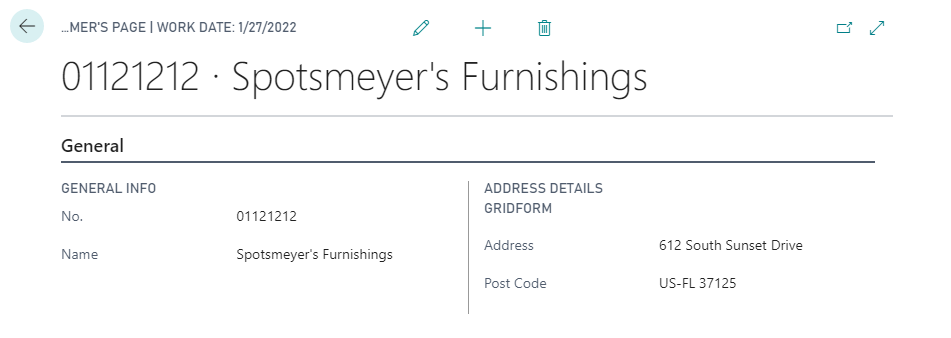Arranging Fields in Rows and Columns Using the Grid Control
By default, fields in a FastTab are arranged automatically in two columns that are based on the number of fields. For more information, see Field Arrangement on a FastTab. You can use a Grid control or a Fixed control to arrange fields in rows and columns on a page and design it to look like a grid-like format or a matrix-like format. To understand the differences between the two controls to help you determine which control to use, see Comparing Grid and Fixed controls.
Note
Grid control for arranging page fields is partially supported.
Using the Grid control, you can arrange the fields manually in one or more rows and columns. The Grid control gives you the following options:
Set up your grid row-by-row or column-by-column.
Span a field across multiple rows and columns.
Show or hide field captions.
Setting-up fields in rows and columns in a FastTab
To set up a grid in row-by-row or column-by-column format, you define the Grid control in a FastTab of a page. You must define the Grid control in a group and specify how you want to arrange the fields by using the GridLayout property. For more information, see GridLayout Property.
Example
The following example demonstrates how to structure a page in a grid-like format.
page 50113 "Customers Page"
{
PageType = Card;
SourceTable = Customer;
layout
{
area(content)
{
group(General)
{
grid(MyGrid)
{
group("General Info")
{
field("No."; "No.")
{
ApplicationArea = All;
}
field(Name; Name)
{
ApplicationArea = All;
}
field("E-Mail"; "E-Mail")
{
ShowCaption = false;
ApplicationArea = All;
}
}
group("Address Details")
{
grid(Grid2)
{
group(GridForm)
{
field(Address; Address)
{
ApplicationArea = All;
}
field("Post Code"; "Post Code")
{
ApplicationArea = All;
}
}
}
}
}
}
}
}
}
The following screenshot shows how the resulting page looks like from the Web client.

Setting fields to span multiple rows and columns
You can set a field to span multiple rows or columns. When you set a field to span multiple rows, the field occupies the cells in the rows below it, and existing fields in the occupied cells are moved to the right. When you set a field to span multiple columns, the field occupies the cells in the columns to the left, and existing fields in the occupied cells are moved to the right. You can also set a field to span multiple rows and columns.
Important
The Dynamics 365 Business Central web client does not support row and column spanning for fields. If the page displays in the Dynamics 365 Business Central web client, the fields appear without spanning.
For example, the following figure illustrates a Grid control that consists of six fields arranged in three rows.

If you set Field 2 to span two rows, then the following layout is displayed:

When you set a field to span multiple columns, the field occupies the cells in the columns to the right, and existing fields in the occupied cells are moved to the right. Using the previous Grid example, if you set Field 2 to span two columns instead of two rows, the following layout is displayed:

You can also set a field to span multiple rows and columns. For example, if you set Field 2 to span two rows and two columns, the following layout is displayed:
 +
+
Set a field to span rows and columns
When you set the Grid control, the fields of that group can be set to span rows or columns.
To set a field to span one or more rows, set the value of the RowSpan property to the number of rows. For more information, see RowSpan Property.
To set a field to span one or more columns, set the value of the ColumnSpan property to the number of columns. For more information, see ColumnSpan Property.
Note
The RowSpan and ColumnSpan properties on fields in the grid layout are not supported in the Dynamics 365 Business Central web client. The Rows layout on the grid control itself is not supported.
Hiding field captions
You can hide the caption of a group or a field. To hide the caption of a field, set the value of the ShowCaption property to False. For more information, see ShowCaption Property.
Related information
Field Arrangement on FastTabs
Arranging Fields Using Grid and Fixed Controls
Arranging Fields in Rows and Columns Using the Fixed Control.